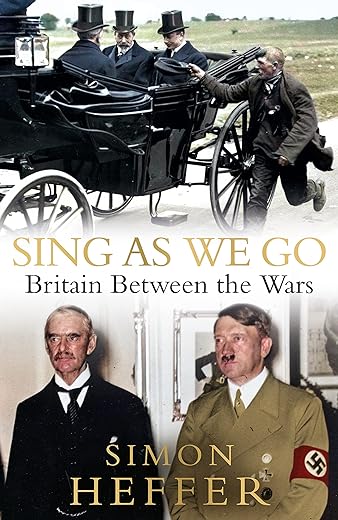Sing As We Go: Britain Between the Wars
£27.10£33.30 (-19%)
Sing As We Go is an astonishingly ambitious overview of the political, social and cultural history of the country from 1919 to 1939.
It explores and explains the politics of the period, and puts such moments of national turmoil as the General Strike of 1926 and the Abdication Crisis of 1936 under the microscope. It offers pen portraits of the era’s most significant figures. It traces the changing face of Britain as cars made their first mass appearance, the suburbs sprawled, and radio and cinema became the means of mass entertainment. And it probes the deep divisions that split the nation: between the haves and have-nots, between warring ideological factions, and between those who promoted accommodation with fascism in Europe and those who bitterly opposed it.
__________________________________________
Praise for the series:
‘Scholarly, objective and extremely well written. A masterclass . . . Heffer’s eye for the telling detail is evident on almost every page.’ Andrew Roberts, 5*, Telegraph
‘Gloriously rich and spirited . . . colourful, character driven history.’ Dominic Sandbrook, Sunday Times
‘Enlightening . . . Robust opinion, an eye for telling detail and a gift for bringing historical figures alive.’
History Books of the Year, Daily Mail
Read more
Additional information
| Publisher | Hutchinson Heinemann (21 Sept. 2023) |
|---|---|
| Language | English |
| Hardcover | 960 pages |
| ISBN-10 | 152915264X |
| ISBN-13 | 978-1529152647 |
| Dimensions | 16.2 x 5.8 x 24 cm |












by Dr CMS Catherwood: writer and reader
This is a magnificent finale to a wonderful quartet of books that look at British history over the crucial century 1838-1939. I especially enjoyed Heffer’s wonderful treatment of the Munich crisis of 1938, looking at it objectively in a way that demolishes many a revisionist account. It is the balance he demonstrates that is especially valuable. And it is also easy to read for non-specialists. What a shame that the four books are now completed, with no more volumes to which to look forward. History as it should be written.
by D.N.SMITH
Love the book,but not the damage on delivery !!!
by Amazon Customer
Do Penguin/Random House not employ Editors these days? By the time I untangled the following sentence opening Chapter 2 I had almost lost the will to live: “Lloyd George had won the election of December 1918 – known as ‘the coupon election’ after H H Asquith, the former prime minister, a casualty of it, described those candidates endorsed by the ruling Coalition as having received ‘the coupon’ (a letter of commendation from the Coalition whips’ office) – with an overwhelming majority.”
by Ali
Sing As We Go: Britain Between the Wars by Simon Heffer serves as an intricate tapestry, weaving together a narrative of Britain’s political and social fabric during the tumultuous period between the two World Wars. The era, marked by significant upheavals, transformative societal shifts, and the rise of new technologies, has long been a subject of immense interest to historians and general readers alike. Heffer’s meticulous account provides a nuanced understanding that transcends mere recounting of events.
The core strength of this volume lies in its in-depth examination of critical episodes like the General Strike of 1926 and the Abdication Crisis of 1936. Whereas many authors gloss over the complexities of these events, presenting them in broad strokes, Heffer delves deep, offering readers not just a surface-level overview but a thorough analysis. This detailed approach allows for a more comprehensive grasp of the motivations, challenges, and outcomes associated with each of these historical moments.
Simon Heffer’s ability to craft compelling pen portraits of the era’s most notable figures stands out distinctly. He doesn’t simply list accomplishments or facts but manages to breathe life into these characters. As I navigated through the pages, it felt as if I was being introduced to real, multidimensional individuals rather than mere historical artifacts. This personal touch is a testament to Heffer’s prowess as both a researcher and a storyteller.
Furthermore, the book captures the transformation of Britain’s landscape and culture with the advent of cars, the spread of suburbs, and the rising popularity of radio and cinema. Heffer’s vivid descriptions transported me to a time when these innovations were reshaping everyday life, bringing both excitement and apprehension. Through his narrative, one gains an understanding of how these technological and cultural shifts played a role in defining the era’s ethos.
Yet, what resonated most with me was the book’s exploration of the deep societal divisions that permeated this period. The chasm between the affluent and the less fortunate, the ideological battles, and the controversial stance on Europe’s rising fascism are all examined with a discerning eye. Heffer doesn’t shy away from presenting the contradictions and conflicts of the time, giving readers a more holistic view of the challenges Britain faced.
The author’s background, as highlighted in the introductory details about Simon Heffer, further instilled confidence in the accuracy and authenticity of the content. His extensive experience in journalism, combined with his academic qualifications, lends a certain gravitas to the narrative. Having read some of his previous works, I could see the evolution of his writing style and his ever-deepening understanding of British history.
However, no review would be complete without addressing potential areas of improvement. While Heffer’s depth is commendable, at times, the intricate details might be overwhelming for readers unfamiliar with the period. A more streamlined approach, perhaps with a concise timeline or summary points at the beginning of each chapter, might aid in navigation and comprehension.
In conclusion, Sing As We Go: Britain Between the Wars stands as a monumental contribution to the understanding of interwar Britain. Simon Heffer’s impeccable research, combined with his engaging narrative style, makes this book a must-read for anyone keen on delving into this era’s complexities. While it does demand a dedicated and attentive reading, the insights gained are well worth the effort. Through this volume, I gained not only knowledge but a deeper appreciation for the forces that shaped a critical period in Britain’s history.
by annie h
Bought as a gift, excellent value for money thank you
by Amazon Customer
An excellent history of the years between the two world wars.covers social as well as political life. Full of information such as the use of the lash as a punishment was only dropped after 1945
by Bookends
If this truly is the last book in Simon Heffer’s social history of Britain that covers the years 1840-1939, then he finished on an absolute winner.
For me this was my favourite of the four books written, not that the other three weren’t enjoyable, they were, it’s just that I raced through this volume in less than 2 days, devouring the book in two mammoth sittings.
He really brings to life how it was during that 20 tear period between the two World Wars. It’s scholarly, but not too highbrow as to put off the casual reader. But for someone like me who devours social history/political history books covering the period between 1800s-1980s, it describes in intimate detail how life changed in so many ways for the people of this island.
One more book covering the period 1939-45 Simon, and you’d make this social history obsessive very happy indeed.
by Verity Durward
I subscribe to the complimentary nature of the other reviews so don’t wish to repeat what others have said. I particularly appreciated the detailed and engaging characterisation of the key players that are central to this period,
A particular criticism for me was the way the time line of an account can be lost in the determination to jam pack every page/paragraph/sentence with facts, to the detriment of the narrative and it’s time line. It seems to be an occupational hazard for some historians, who are historians first and foremost and writers second. For the sake of completeness, not one precious scrap of the research can de discarded often at the expense of readability, brevity and clarity.
As much as I enjoyed this book, I found it hard going. Unduly long sentences, bloated with the last titbits of info., often had me reading sections more than once to be sure that I’d got the thread: frequently I had to backtrack to find out where I was in relation to time or place.
I read a lot of history and authors vary greatly in these respects. Orlando Figes on the Russian Revolution and Peter Francopan on the Silk Road know how to write a ‘page turner’. Other writers on the same same subjects have produced ‘seed catalogues’ where any story is hard to find despite a scattering of conjunctions and prepositions in an effort to join the information together. Normally, Simon Heffer is not in this category. Perhaps the editing could have been much sharper.
Nonetheless, I wholeheartedly recommend this book to any history lover who seeks such valuable insights to this crucial part of our history.